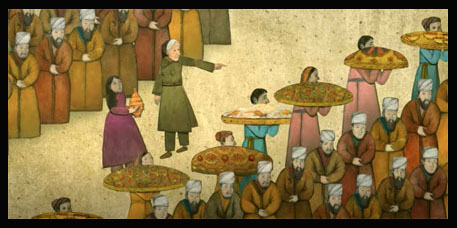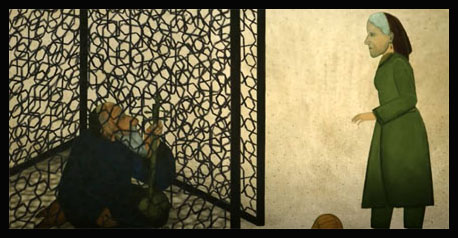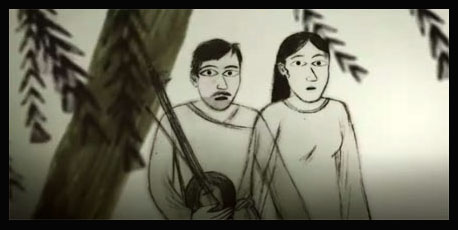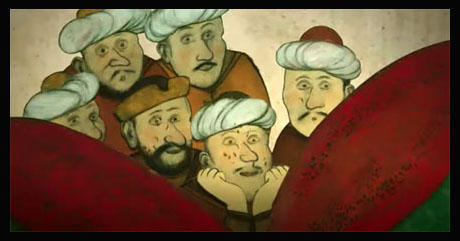
The Musician is directed by Reza Riahi and produced by Eleanor Coleman. It’s a dramatic animated short about an unexpected reunion between a man and a woman during the attack of the Mongols. This powerful story and stop-motion, paper cut-out techniques helped earn The Musician Best Animated Short Film honors at last year’s Tribeca Film Festival. And now it’s one of the 15 finalists for the Academy Award. (This Q&A with Reza and Eleanor was edited for length and clarity.)
Jackson Murphy: I saw this short last year through Tribeca. What was that experience like?
Reza Riahi: Of course I was honored, but I really wish that I could’ve been there too. We really wanted to participate in person but COVID gave that… bad luck.

Eleanor Coleman: We had quite humble ambitions for this film. We just wanted to make it, and we had no idea that it would resonate so strongly with people around the world. It premiered in Toronto, initially, which was incredible for us. And then it kept being in festivals and snowballing. And Tribeca was definitely a major high point. We’re just thrilled. It’s super exciting.
JM: Great. Reza, where exactly did the inspiration come from to tell this painful love story? Was it history? Was it the idea of forbidden love? Or was it a little bit of both?
RR: A little bit of both and a mix of so many things. I was always very curious and stunned by miniature art… and all the stories between the lovers and the kings and the metaphoric things. And also I was listening to this instrument, the Kamancheh (in the violin family), so I was really struck by the… mystical sound. So It’s kind of mixing all this together.
JM: Nice. And Eleanor, one of the themes I got from this is the power of memories and the power of flashbacks — and how we want to remember certain events in our lives. How did that theme really come across for you as you became attached to this project?
EC: That’s what’s so powerful about this film. You see it from the woman’s perspective. That’s how you’re really pulled into her having these memories that are provoked by the music. I think it’s a really beautiful example of the elasticity of time. These two characters have been separated for over 50 years and yet when she discovers that he’s still alive and still playing, it is completely transformative for her. She goes out of her daily life and into this kind of reverie. And the way Reza chose to do it in two techniques really intensifies that experience. You get pulled with her into her memories and you then see how her memories mix with her daily experience.

JM: You’re right that it’s an intense experience. Reza, you make consistently strong story decisions and pacing decisions. What were some of the challenges when it came to pacing?
RR: That was from the core of the film when I started writing it. I [didn’t do it] in a classic way. I started to write about this party scene. I was always thinking of this back and forth between these two lovers — and after that I started to think, “Okay there’s got to be so much action. I got to calm this down.” Or “I need to play with the audience so they’re not going to [dislike] this 15 minutes of animation.” So I really wanted to entertain the audience and also give enough information so they can be moved and understand the intention and the story of the two lovers.
JM: It’s a very serious short but at the same time… you leave us with a really powerful, dramatic ending, which is very strong… Do you find, though, Eleanor, there’s a little bit of a sense of hope that we should be feeling towards the end?
EC: Absolutely. This is a film about people’s resilience. This is about how people continue on with their lives in the face of horribly dramatic experiences. In this case it’s because of war or attack. This is something people around the world every day are faced with right now. We have examples… when you’re not inundated with COVID… there’s a lot of other things going on in the world right now. All of these are examples of people being displaced and being attacked and being oppressed. How do they continue? How do they go on? In a way it’s kind of a hymn to love but also to the strength of the human spirit.

JM: I agree with you there. Reza, you have to tell me about these paper cut-outs — their delicacy and what you were able to do with them.
RR: The idea was very obvious to me that we were going to do paper cut-outs. But how I started to make it: that was a long research on the internet. I didn’t want the audience to get involved with the technique. The movements have to be so smooth and all the turns have to feel so real. I really wanted the audience to get into the story and into the atmosphere without just seeing actual paper. I knew production-wise it was going to be crazy. We had over 200 puppets. We had thousands of hands. All that to organize and to be able to use them in perfect positions that we needed. Fortunately I had a… perfect, professional team that already had so much experience in stop-motion. We organized this and I worked for six months — almost every day — to achieve the result that we actually aimed for.
JM: All that hard work paid off because it looks so good. You’re right that you can admire the technique but it’s not distracting. One of the other elements that I really like is how this story is told through facial expressions — just slight movements and slight changes. How important was that, Reza — to just look at somebody in a moment and that says everything you need to know?
RR: We don’t have dialogue, so the only sound of the film is the music. The moments that we don’t have music, the only thing that’s communicated… without any dialogue is the gestures and looking at the eyes. That was really tricky. We added the second layer of the plastic treated. I found something for the animators to draw and raise at the same time they’re moving the paper. It was a double task for animators. And we didn’t have any control to go back for mistakes. We had to go forward. Technically it was very challenging but we pushed to have this eye contact in. Otherwise we couldn’t understand what was going on exactly between those two characters.

JM: Eleanor, I want to ask you about the MTV and Paramount involvement here. You’ve got a major partner in Paramount+. How has that really benefited the success of this short over these past few months?
EC: The support of the team from Viacom is extraordinary. We are modest filmmakers living in France. This is a whole new experience for us, but we’re so touched by their efficiency and generosity and enthusiasm and communication. It’s a fantastic experience, and that is all really due to Tribeca. It’s that classic dream of a short film. It starts out with going to a supply store and buying a bunch of pieces of paper and then bringing together an incredible group of people to make a film — and then we have a fantastic distributor, who is very well versed in the international festival scene. It just snowballed and it has definitely accelerated since we got involved with MTV/Viacom. We certainly can’t thank them enough.
JM: Fantastic. Have you thought about potentially being an Oscar nominee — what that would mean to you?
RR: Yeah, I’ve thought about that. (laughs) It sounds crazy because as Eleanor said we’re very humbled filmmakers. We would be very happy. We’re proud. All the members of the team, from Saba Alizadeh who did the music and Eleanor and the producers and the animators — everyone deserves to be known by this film. It’s not just my film. It’s a group… teamwork… let’s see what happens!
EC: [It would be] Extraordinary. I’m just so thankful to get so much fantastic support here in France for the film. We got national and regional support. When you make a film like this that’s entirely handmade, you basically want to make it to the end. (laughs) And hope that everything works! And it was quite a challenge. There’s no dialogue. Our musician is based in Tehran. He’s doing all the work from there. It was a very technical project because there’s two different kinds of stop-motion and the animators were animating to the music. They were actually using videos that Saba recorded of himself playing the Kamancheh, so they could animate the musician exactly to the music. That was really the huge challenge and also the huge joy because of the spirit that went on with the team. And after that, it’s sort of extraordinary. You just get on the ride and do your best.
- INTERVIEW: Jeff Fowler On “Knuckles” And “Sonic 3” - April 22, 2024
- INTERVIEW: “Inside Out 2” Director And Producer On Pixar Sequel - April 16, 2024
- INTERVIEW: “Puffin Rock And The New Friends” And 25 Years Of Cartoon Saloon - April 10, 2024


 January 14th, 2022
January 14th, 2022  Jackson Murphy
Jackson Murphy  Posted in
Posted in  Tags:
Tags: 






